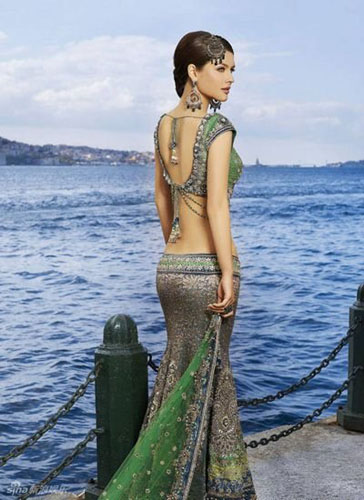 Kazia Jaszkiewicz
Kazia Jaszkiewicz Rita Galkina
Rita Galkina Faustine Lara
Faustine Lara Kristin G
Kristin G Martina M
Martina M
 Lady Gaga is lending star power to Polaroid and the MIT Museum.
Lady Gaga is lending star power to Polaroid and the MIT Museum.
The pop star known for her outlandish wardrobe posed Wednesday for a Polaroid at the museum run by the Massachusetts Institute of Technology. In January, she was given the title of creative director for the company that owns the iconic photography brand.
The museum had recently taken possession of thousands of Polaroid inventions that revolutionized photography in the 20th century, including the 20- by 24-inch camera that was used to snap the photo of Lady Gaga wearing a low-cut black lace dress. Lady Gaga has concerts in Boston on Thursday and Friday nights.
Polaroid was founded in Cambridge in 1937. It was sold in bankruptcy last year and is owned by Minnetonka, Minn.-based PLR IP Holdings.
 Pop princess Britney Spears is joining the growing club of celebrities-turned-designers, launching her own fashion collection that targets the schoolgirl crowd.
Pop princess Britney Spears is joining the growing club of celebrities-turned-designers, launching her own fashion collection that targets the schoolgirl crowd.
Spears, 28, has designed her first collection of clothing and accessories for the Iconix Brand Group Inc's Candie's brand for which she has been the face for the past three seasons.
The juniors' collection, called "Britney for Candie's," will be sold exclusively in Kohl's Department stories from July 1 to kick off the back-to-school season.
"Designing was a really fun, new way for me to express my creativity and I really wanted to create something by me for my fans," Spears said in a statement.
She said the collection, inspired by her favorite music and movies, as a mixture of day and evening looks, ranging from jeans to little black dresses.
A print and television advertising campaign to promote the line features the tagline: "Designed by me for you!"
Spears earlier this year ended a world tour to support her 2008 album "Circus" which was widely regarded as her comeback after a public meltdown when the singer lost custody of her two children, did stints in rehab and shaved her head.
She rocketed to fame as a teenager 10 years ago with hits like "Baby One More Time" and is still one of the best-known celebrities in the world.
According to statistics from China Customs and Ministry of Finance of Japan, China textile export during January to April in 2010 to Japan decreases compared to the same period last year. Moreover, China textile share of Japan textile market shrinks. Although Japanese economy maintains going out of crisis, the expectation of China textile export to Japan is not optimistic because of the bad textile sales in Japan and other uncertain factors.
Statistics from China Customs show that the textile export value to Japan during January to April in 2010 is 6.849 billion US dollars, down 3.67% compared to the same period last year.
Statistics from Ministry of Finance of Japan show that China's textile export value to Japan during January to April in 2010 is 7.846 billion US dollars, decreasing 4.52% compared to the same period last year. Although China and Japan's measurement tools differ, we still can see the drop from both statistics.
According to Ministry of Finance of Japan, Japan's total textile import value during January to April in 2010 is 10.246 billion US dollars. Import value from China takes 76.57%, falling 1.82%.
The main reason of drop of China's textile export to Japan is the bad sales of textile. However, competition from Vietnam and Thailand cannot be ignored. Japan's textile import from Vietnam increases by 3.59%. Thailand enjoys a growth of 5.52%.
China and Taiwan signed a historic deal on Tuesday to boost $100 billion in two-way trade after decades of hostility, easing political ties while putting the export-reliant island closer
to its biggest market.
The strongest tie-up between self-ruled Taiwan and China, which claims sovereignty over the island, will slash tariffs on about 800 items. It heavily favors Taiwan as economic powerhouse China seeks to offer sweeteners toward its goal of political unification.
The euphoria, though, could start to fade quickly once the two move into the next, much tougher round of negotiations.
The tariff-slashing economic cooperation framework agreement (ECFA) follows 60 years of antagonism that has brought the two to the brink of war.
The pact, talks on which began in 2008 under China-friendly Taiwan president Ma Ying-jeou, covers only the easiest 800 of thousands of items targeted for eventual tariff cuts to lift $100 billion annual two-way trade.
The next round could start as soon as December, when Taiwan will push its economic powerhouse neighbor to lower tariffs on the island's most prized exports, such as PVC plastics and high-tech items. Beijing is seen resisting to protect its own industries.
Future talks, also covering sensitive Taiwan-made autos and machine tools, will make up what Ma has described as a "post-ECFA era," crucial to an island with almost no free trade deals as China marginalizes it internationally.
"The main course is still to come," he said.
The pact will cut tariffs to zero on 539 Taiwan export items worth $13.84 billion bound for China versus only 267 valued at $2.86 billion headed the other way.
Exporters will do cheaper business in China, already Taiwan's biggest trade partner and top investment destination, as the tariffs disappear two years after the deal signing in Chongqing, a former wartime capital for Taiwan's ruling Nationalists.
Analysts say Beijing wants the trade deal less for its economic benefits than as a way to charm Taiwan into political reunification with China. China has claimed self-ruled Taiwan since the Nationalists fled there in 1949 after losing the Chinese civil war.
Wooing Taiwan would be a major achievement for Chinese President Hu Jintao, who is due to step down after his Communist Party selects a new top leader in 2012.
But tensions could rise again as the items from Taiwan's top industries looming on the agenda for future tariff talks compete too closely with industries China wants to develop.
"Taiwan will put out all options and see what China says," said David Cohen, director of Asian economic forecasting with Action Economics in Singapore.
China may also try to push farm products on Taiwan despite farmer opposition, the island government said.
If Beijing plays tough, an outcry at home could make the Taiwan government may pull back. Opposition would be particularly loud if the ECFA itself creates well short of the 260,000 Taiwan jobs expected or fails to lift the island's GDP by a forecast 1.7 percent.
Taiwan also hopes Beijing will let the ECFA lead the island to free trade agreements with other major economies, such as Japan and the United States. Beijing has said it would forbid those FTAs because Taiwan lacks sovereignty.
"ECFA is about breaking the log jam which will allow Taiwan to go out into the world," said Steve Tsang, a China-Taiwan relations expert at St Anthony's College, Oxford University.
Friction over tariffs or FTAs could hurt China talks and push them onto the 2012 presidential election agenda.
"The general consensus is that China will not allow talks to break down," said Joseph Cheng, political scientist at City University of Hong Kong.
Organized by Haining Leather Expo Center and Haining Leather City, 2010 China Leather Fashion Week will kick off on 12th July in Haining. This fashion week is supported by CLIA and China National Garment Association. Famous brands such as OSSTINA, MODEKUU and FOOR and so on will display their latest creations at the fashion week.
As the largest leather industry cluster in China, Haining of Zhejiang province recently becomes the leather fashion center. Haining leather wear has already become fashion products rather than warm-keeping products due to the use of various materials and creative designs.
Haining Leather Fashion Week started in 2008. From then on, this fashion week became the stage for the display of leather garment enterprises. At this year's fashion week, you will find leather garments of all four seasons.
Two years after it ventured into India through a 30:70 joint venture with DLF Brands, Italian menswear brand Boggi Milano said it will be setting up at least 30-35 stores by 2015 with an estimated investment of €10-12 million.
The company is eyeing travel retail and will begin its inning at the new airport terminal. “We are familiar with travel retail and believe it will be an additional revenue stream. We will be launching two stores exclusively out of the new terminal. It will help in brand building and also trigger impulse purchase,” Mr Giorgio Brandazza, Brand Director, Boggi Milano, told Business Line.
The company operates in over a dozen countries and has around 80 exclusive outlets across the world.
"There has been a 100 per cent growth for us in the Indian market. Our idea is to be at multiple locations. For the current fiscal, we will be setting up five stores of which two will be at the airport,” he said. Boggi currently has three stores in India. Boggi Milano is setting up stores in Kolkata, Bangalore and Chennai. The company has so far invested about €1.5 million.
Additionally, the company is also exploring the possibility of sourcing out of India. “However, there are concerns regarding quality, therefore, we are going slow on it,” Mr Brandazza said, adding that it will be forming a local team to go ahead with its sourcing plan.
Boggi offers menswear clothing and accessories for both work and leisure. The range starts from Rs 2500 for a shirt and Rs 30,000 for suits.
Asked if the Boggi Milano will tweak prices for the Indian market, Mr Brandazza said the company will not effect any price cut. “The prices will be same as international prices. However, we will be creating cuts especially for the Indian market”.
Models battling out on the ramp are now fighting it out with their fashion labels. Megan Gale is introducing her new swimwear brand, Isola, and is directly competing with Jennifer Hawkins’, Cozi range.
Off late, Gale and Hawkins were head-to-head, battling it out as envoys of Australia’s competing department stores, Myer and David Jones, respectively. However, now this war has moved a step up, with Gale launching her brand in the same market, wherein, Hawkins had launched her range Cozi, 11 months ago.
The swimwear industry is all set to melt the ice this winter, with the launch of Gale’s new line in Sydney, moving against Hawkins’ latest collection, Cozi 2010-11, which is scheduled to be launched in mid-July.
But, the main challenge for both is to carve a niche for their brands in a rapidly growing swimwear fashion industry.
Currently, 65 Myer stores house Hawkin’s Cozi, whereas Gale’s Isola line has already secure floor space in David Jone’s 35 stores.
More so, both lines have on their platter a wide range of shapes and sizes to woo different body types and are aimed at those women, who are in their early 20s and late 30s, and treat swimwear as an essential part of their wardrobe.
Ashburn Hill Corp.’s TECGEN brand team has announced a new line of TECGEN SELECT garments that offer built-in flame-resistance and Insect Shield repellent technology. The latest in the line of next-generation TECGEN SELECT protective apparel, the new Insect Shield repellent technology option provides the benefit of repelling pesky insects while maintaining the protective performance expected from garments made with TECGEN fiber.
TECGEN SELECT brand garments with Insect Shield repellent technology debuted at the Edison Electric Institute (EEI) Occupational Safety & Health Committee Conference in New Orleans in April. They will continue to be showcased at the VPPPA show in Orlando this August and at the NSC 2010 Congress and Expo in San Diego this October.
Insect Shield repellent technology is the first-ever EPA-registered insect-repellent clothing. Recently, the EPA has granted Insect Shield extended durability claims for its apparel registration through 70 washings. Seventy washings is nearly three-times the longevity of the product’s original EPA apparel registration at 25 washings. Insect Shield apparel and gear products combine a patent-pending process with a proprietary formulation of the insect repellent permethrin, resulting in effective, odorless insect protection that lasts the expected lifetime of a garment.
Other benefits of the garments include:
• NFPA 70E HRC 2 and NFPA 2112 certification, meeting and exceeding compliance standards and protecting you from radiant heat, electric arc fires and flash fires.
• Year-round comfort – lightweight , breathable, and designed to wick sweat away from the skin.
• Inherent flame-resistance – made with patented TECGEN fiber for protection that will not wash or wear away.
• From the makers of TECGEN XTREME garments – non-structural turnout gear for firefighters.
Garments made with patented, bi-regional TECGEN fiber technology take comfort and moisture-management in flame-resistant protective apparel to the next level through their lightweight fabric, high air permeability and wicking action that transport moisture away from the skin.
"For years, employees exposed to flash-fire and arc-flash related hazards have had to struggle with balancing comfort and protection,” explains David Osbon, global director of sales and marketing for Ashburn Hill Corp. “In most applications, previously available fabrics and garments available provided the necessary protection while sacrificing comfort. Research-and-development efforts over the last few years have focused on maintaining protection while improving comfort.”
Ashburn Hill Corporation is focused on delivering comfortable protective garment people will want to wear, and TECGEN SELECT brand protective garments are designed to achieve this goal.
Neha Dalvi is an Indian model and actress from Mumbai, India. Neha Dalvi is ready to compete in “Miss India″ and “Miss World″. She is compared with her beauty and attire with Miss World 1994 Aishwarya Rai Bachchan. She has won many best female model awards in many colleges. She will be seen in her forthcoming Bollywood Movies. Neha Dalvi is seen in the famous hoarding of Seasons Saree showroom which was a hit all over.




Playboy Enterprises said it is cutting staff in an effort to save more than $3 million annually as it transitions from a media company into one that primarily licenses the Playboy brand.
The company declined to say on Tuesday how many employees are affected by the move. At the end of March, Playboy employed 573 people in its Los Angeles and Chicago offices, down from 651 a year ago.
In December, Playboy was in talks to sell itself to the Iconix Brand Group, a company that licenses clothing brands such as Joe Boxer, but no deal was reached.
Playboy Chief Executive Scott Flanders said in a statement the company is "aggressively looking" for ways to streamline the organization.
Playboy is trying to capitalize on its iconic bunny ears logo by signing licensing deals with clothing makers, casinos and clubs as it moves away from its reliance on print advertising from its magazine.
The company expects to take restructuring charge of approximately $3 million in the second-quarter.